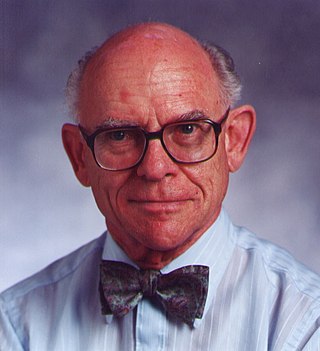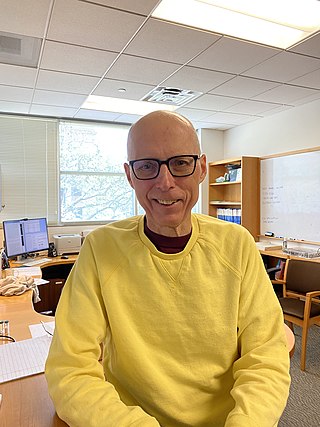Related Research Articles

Henry Taube was a Canadian-born American chemist who was awarded the 1983 Nobel Prize in Chemistry for "his work in the mechanisms of electron-transfer reactions, especially in metal complexes." He was the second Canadian-born chemist to win the Nobel Prize, and remains the only Saskatchewanian-born Nobel laureate. Taube completed his undergraduate and master's degrees at the University of Saskatchewan, and his PhD from the University of California, Berkeley. After finishing graduate school, Taube worked at Cornell University, the University of Chicago and Stanford University.
Marion Frederick Hawthorne was an inorganic chemist who made contributions to the chemistry of boron hydrides, especially their clusters.

Frank Albert Cotton FRS was an American chemist. He was the W.T. Doherty-Welch Foundation Chair and Distinguished Professor of Chemistry at Texas A&M University. He authored over 1600 scientific articles. Cotton was recognized for his research on the chemistry of the transition metals.
The Willard Gibbs Award, presented by the Chicago Section of the American Chemical Society, was established in 1910 by William A. Converse (1862–1940), a former Chairman and Secretary of the Chicago Section of the society and named for Professor Josiah Willard Gibbs (1839–1903) of Yale University. Gibbs, whose formulation of the Phase Rule founded a new science, is considered by many to be the only American-born scientist whose discoveries are as fundamental in nature as those of Newton and Galileo.
The Agnes Fay Morgan Research Award was established in 1951 by the Iota Sigma Pi honorary society for women in chemistry. The award is given for research achievement in chemistry or biochemistry to a woman not over forty years of age at the time of her nomination. Individual chapters, Iota Sigma Pi members, chemists, and groups of chemists may nominate eligible chemists for the prize.
Arthur E. Martell was a distinguished professor of chemistry at Texas A&M University and award-winning researcher in the field of inorganic chemistry.

Francis Gordon Albert Stone CBE, FRS, FRSC, always known as Gordon, was a British chemist who was a prolific and decorated scholar. He specialized in the synthesis of main group and transition metal organometallic compounds. He was the author of more than 900 academic publications resulting in an h-index of 72 in 2011.

Narayan S. Hosmane is an Indian-born cancer research scientist who made the featured article in NRI Achievers magazine and is currently distinguished research professor of Chemistry and Biochemistry. He received the Humboldt Research Award for senior scientists twice. This award is presented annually to scientists worldwide as a tribute to their lifelong accomplishments by Alexander von Humboldt Foundation, Bonn, Germany.
Christopher J. Chang is an American chemist and the Edward and Virginia Taylor Professor of Bioorganic Chemistry at Princeton University. Previously, he was a professor of chemistry and of molecular and cell biology at the University of California, Berkeley, where he holds the Class of 1942 Chair. Chang is also a member of the Helen Wills Neuroscience Institute, a Howard Hughes Medical Institute investigator, adjunct professor of pharmaceutical chemistry at the University of California, San Francisco, and faculty scientist at the chemical sciences division of Lawrence Berkeley Lab. He is the recipient of several awards for his research in bioinorganic chemistry, molecular and chemical biology.

Stephen James Lippard is the Arthur Amos Noyes Emeritus Professor of Chemistry at the Massachusetts Institute of Technology. He is considered one of the founders of bioinorganic chemistry, studying the interactions of nonliving substances such as metals with biological systems. He is also considered a founder of metalloneurochemistry, the study of metal ions and their effects in the brain and nervous system. He has done pioneering work in understanding protein structure and synthesis, the enzymatic functions of methane monooxygenase (MMO), and the mechanisms of cisplatin anticancer drugs. His work has applications for the treatment of cancer, for bioremediation of the environment, and for the development of synthetic methanol-based fuels.
Marcetta York Darensbourg is an American inorganic chemist. She is a Distinguished Professor of Chemistry at Texas A&M University. Her current work focuses on iron hydrogenases and iron nitrosyl complexes.
William J. Evans is a Distinguished Professor at the University of California, Irvine, who specializes in the inorganic and organometallic chemistry of heavy metals, specifically the rare earth metals, actinides, and bismuth. He has published over 500 peer-reviewed research papers on these topics.
Clifford P. Kubiak is an American inorganic chemist, currently a Distinguished Professor in Chemistry and Biochemistry and the Harold C. Urey Chair in Chemistry at the University of California, San Diego. Over the course of his career, Kubiak has published over 200 scientific articles. He has also received the American Chemical Society Award in Inorganic Chemistry, and is a Fellow of the American Academy of Arts and Sciences and American Chemical Society. In 2020 he was elected to the National Academy of Sciences.
Kim R. Dunbar is an American inorganic chemist and Distinguished Professor of Chemistry at Texas A&M University. Her research concerns inorganic and coordination chemistry, including molecular magnetism, metals in medicine, supramolecular chemistry Involving anions and anion-pi interactions, and multifunctional materials with organic radicals.
George Christou is a British-American chemist, currently the Drago and Distinguished Professor at the University of Florida, previously the Earl Blough Professor at the Indiana University. He is also an Honorary Professor at London Centre for Nanotechnology. His current interests are in bioinorganic chemistry, materials and nanoscale magnets, and supramolecular and cluster chemistry. He was a pioneer of the field of single-molecule magnets and has been a significant figure in inorganic chemistry, with multiple papers each cited over 100 times. He has published over 600 peer-reviewed publications, with an H index of 96, and has been selected to both the Highly Cited Researchers 2014 and 2015 lists. He has received a variety of awards and honours over the years, including the recent American Chemical Society 2019 ACS Award in Inorganic Chemistry, the 2017 SEC Faculty Achievement Award, the 2016 Southern Chemist Award, and the 2016 Nyholm Prize of the UK Royal Society of Chemistry. He was named one of 15 Florida Most Influential Scientists.

Gregory H. RobinsonFRSC is an American synthetic inorganic chemist and a Foundation Distinguished Professor of Chemistry at the University of Georgia. Robinson's research focuses on unusual bonding motifs and low oxidation state chemistry of molecules containing main group elements such as boron, gallium, germanium, phosphorus, magnesium, and silicon. He has published over 150 research articles, and was elected to the National Academy of Sciences in 2021.

John A. Gladysz, an organometallic chemist, is a Distinguished Professor and holds the Dow Chair in Chemical Invention at Texas A&M University. Professor Gladysz is a native of the Kalamazoo, Michigan area. He obtained his B.S. degree from the University of Michigan (1971) and his Ph.D. degree from Stanford University (1974). He subsequently held faculty positions at UCLA (1974-1982) and the University of Utah (1982-1998). He then accepted the Chair of Organic Chemistry at the University of Erlangen-Nuremberg in Germany. In 2008, he returned to North America as a distinguished professor and holder of the Dow Chair in Chemical Invention at Texas A&M University.

Deanna Michelle D'Alessandro is an Australian chemist who is a Professor and Australian Research Council Future Fellow at the University of Sydney. Her research considers fundamental aspects of electron transfer in molecular coordination complexes and in nanoporous materials, and the development of metal–organic frameworks for environmental applications including carbon dioxide capture and conversion.
Robert J. Gilliard, Jr. is an American chemist and researcher who is the Novartis Associate Professor of Chemistry at Massachusetts Institute of Technology. His research involves the synthesis of molecules for energy storage, molecular materials, and main-group element mediated bond activation. He is a member of the editorial advisory board at Inorganic Chemistry, Chemical Communications, and Angewandte Chemie, among other scientific journals.
Krishnan Rajeshwar is a chemist, researcher and academic. He is a Distinguished University Professor and Founding Director of the Center for Renewable Energy Science & Technology at The University of Texas at Arlington.
References
- ↑ "2022 NAS Election".
- 1 2 "Prof. Donald J. Darensbourg". Texas A&M University.
- ↑ "Five Science Faculty Honored as Distinguished Professors" (Press release). Texas A&M University. 6 Sep 2010.
- ↑ Henton, Lesley (2023-03-28). "Chemist Donald Darensbourg Honored With 2023 SEC Faculty Achievement Award". Texas A&M Today. Retrieved 2024-10-16.